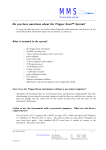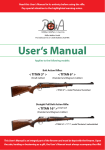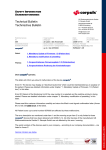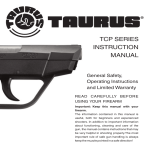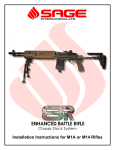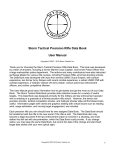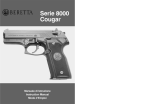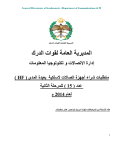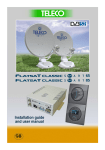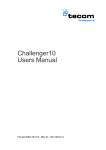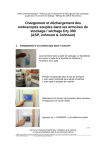Download ICback
Transcript
MANTHEI MESS SYSTEME The Trigger Scan System Computerized Trigger Analysis We show feelings! Vers. 1.1 gb. oV © 1999 MMS MANTHEI MESS SYSTEME Thank you for your interest in the Trigger Scan system. We would like to introduce you to the possibilities of this instrument. The presentation offers different ways to explore the Trigger Scan system. Choose the desired path by placing the cursor on the colored text and clicking on it with the left mouse button. To reach the next screen just push any key or the left mouse button. Please wait until the ! sign disappears and the " sign in the lower right corner of the screen appears to ensure that all animations of this page are finished. To return to the main menu at all times, place the cursor on the " sign in the lower right corner clicking on it with the left mouse button. The end of any path will take you automatically to the main menu. If you have further questions, please do not hesitate to contact us. © MMS 1999 Axel Manthei Bahnhofstraße 9 86916 Kaufering/ Germany Tel. / Fax +49- (0) 8191-66704 email: [email protected] " ! back Main Menu Which information about the Trigger Scan system would you like to get? • The complete tour • Information about the trigger testing • Information about the spring testing • View specific issues • Where to get the system / Please continue only by choosing one of the contact to MMS topics with a mouse • exit presentation click! © MMS 1999 " ! The Trigger Scan system can • • • • • • graphically display the trigger pull numerically analyze the trigger pull measure the lock time graphically display the force of springs numerically analyze springs measure forces © MMS 1999 " ! back The data of the trigger pull will be analyzed for : • • • • • • © MMS 1999 maximum force travel to actuate initial take-up over travel energy to actuate lock time " ! back force The trigger pull will be displayed in the following manner travel © MMS 1999 numerical analysis " ! back Trigger profile explained: Travel to Actuate Over-travel Peak Force Trigger Actuation Initial Take-up Energy © MMS 1999 Striker Impact " ! Lock Time • The lock time* is measured with a probe inserted into the barrel. The exit of the firing pin from the breech face is detected. • The time will be displayed in the XX,X format in milliseconds. * The lock time is defined as the time between the release of the trigger and the exiting of the firing pin from the breech face. © MMS 1999 " ! back The Trigger Scan Instrument The sensor arm is motorized and measures force during forward and/or backward motion. © MMS 1999 " ! back The fixture • The fixture accommodates firearms of all kinds. • It can be adjusted for small pistols as well as for large match rifles. © MMS 1999 " ! back Adapter for spring measurement • The measuring instrument can be easily adapted for spring measurement © MMS 1999 " ! back Spring measurement • The graph shows a compression profile of a spring. Force versus travel. © MMS 1999 " ! back The spring data will be analyzed for: • spring consistency • stored energy The system can compress a spring to a determined distance or until a set force is reached. With these features a simulation of the actual working condition of the spring is possible. © MMS 1999 " ! back Trigger Scan™ system components • • • • • • • • Instrument with accessories Windows® based software Firearm fixture Lock time sensors Spring measuring adapter Lockable transport case Calibration tools User manual © MMS 1999 " ! back The Trigger Scan System consists of: • Software: • 3.5" installation diskette • Hardware: • lockable carrying case • the Trigger Scan instrument • power adapter © MMS 1999 • • • • • • • • • • 3 piece spring attachment 9 pin serial cable 25 pin serial port cable adapter 8" firing pin sensor 24" firing pin sensor 3 allen wrenches 1 calibration tweaker spare calibration labels. user manual. rifle fixture with a pistol adapter and an adjustable clamp. " ! back The Software The software • • • • is easy to install has a self explaining screen is available in English or German can be switched between metric and imperial units. Already stored data will also be switched. © MMS 1999 " ! back The Work Area Control buttons for all frequent tasks are arranged in the work area, and mouse clickable. The test results are shown in columns on the right side. Test 2 Test 1 Clear Ready Go Stop Two measurements can be evaluated at a time (e.g. Single Action and Double Action). © MMS 1999 Return Analyze Print " ! back The Test Procedure Arms of the instrument are placed in between the trigger and the trigger guard. The fixed arm rests against the trigger guard, while the moving arm compresses the trigger. © MMS 1999 " ! back The Results The received data can be: • • • • © MMS 1999 printed stored in a file retrieved as a file visually compared with self defined control limit lines " ! back What information can the system analyze on a trigger? The system measures the force versus travel • on the usual direction of the trigger pull • on the return of the trigger to the home position • on both directions of the trigger test The force on the trigger, that is returning it to his home position, can be of interest for the evaluation of so called release triggers. It is also useful to ensure the proper function of commonly used trigger systems. The necessary balance between enough force to overcome dirt and a moderate trigger pull can be established on scientific measurements. © MMS 1999 Click for example " ! back The use of the Trigger Scan System • • • • © MMS 1999 Forensic and Firearms Experts Armories Research and Development of Firearms Gunsmiths " ! back Forensic and Firearms experts In the fields of forensic and firearms experts is a scientific method of testing the trigger pull mandatory. Testing the trigger pull with weights was a proven way to determine the maximum force to actuate the trigger but it will not give any information about the changes in force during the travel of the trigger. To detect an inconsistent releasing trigger was also difficult. The Trigger Scan System shows multiple graphs of the same trigger within a matter of seconds. Comparing the force vs. travel graph enables the examiner to give a scientifically founded statement about the consistency of the trigger system. © MMS 1999 " ! back Forensic and Firearms experts Another advantage of the Trigger Scan system over the method with weights is the fact that the firearm is tested in the correct position with horizontal barrel. The difference between a straight or up side down held firearm can also be tested. With a printed Trigger Scan graphic it is easier to explain a characteristic to a person which is not familiar with firearm (e.i. in court). Especially for the quality control in the forensic science it is important that the Trigger Scan ™ system can be checked and if necessary calibrated for proper accuracy. Forensic laboratories in Germany, Austria, Netherlands and the USA are using the Trigger Scan™ system with success. © MMS 1999 " ! back Firearms manufacturing - as a mean of promotion Firearms manufacturer can us the Trigger Scan System in multiple areas. The manufacturer of target or hunting firearms can supply a printed trigger profile together with the rifle or pistol. In this way it is not only documented in what state the trigger of this particular firearm was, when it was delivered. It is also demonstrated, that your Company is using the most scientific tools to insure a proper quality control of the used components. © MMS 1999 " ! back Firearms manufacturing - quality control of the productFor the production quality control is the main issue. With a maximum duration of 15 seconds for the test cycle of the complete trigger characteristic, a random or complete control of the produced firearms can be done in a cost-efficient way. The data can be stored and retrieved if necessary. Statistics for the analysis of the production can be one application. Inquiries of a complaining customer can be checked as well as it could be an advantage in the case of product liability, if one can show evidence that the trigger pull was not below or above the production standards. © MMS 1999 " ! back Example of control limits Control limits like the shown lines can be created easily. With the optical comparison against upper and lower limit lines production test can also be performed by scientific uneducated personal. Upper limit at example at 25 Newton The tested firearm is meeting the required standards. ! The lower limit is as example defined at 17,5 Newton. © MMS 1999 " ! back Firearms manufacturing - research & development The development of trigger systems requires more than the knowledge of the maximum force. The full graph of a trigger characteristic is important. Up till now this could only be checked by feeling with the finger, a usable but not very scientific method. The Trigger Scan system will not only give the force versus travel graph, the system will also analyze the energy put in the trigger to release the firing pin. In a double action trigger the ignition energy is put into the system via the trigger pull. Therefor the energy to actuate the trigger - minus the friction - gives an information about the ignition energy and possible causes for light strikes on the primer. © MMS 1999 " ! back Firearms manufacturing - research & development Measurement of a S&W Revolver shows that 415 Nmm of energy is needed to actuate the trigger. This energy is consumed by compression of the springs and friction of the internal parts. For this revolver, the energy distribution is apparent from the graph. Transfer bar 1 ,4 % Component Trigger spring Cylinder Main spring Transfer bar © MMS 1999 Energy 101,3 N mm 24,4 % 16,6 N mm 4,0 % 292,0 N mm 70,2 % 5,9 N mm 1,4 % Trigger spring 24,4 % Main spring 70,2 % Cylinder transport 4% " ! back The gunsmith Rough areas in the trigger characteristics Variation in trigger quality between six chambers result of uneven cylinder transport. Customers who complain about trigger quality can visualize the problem. After the problem is eliminated (sale of a trigger job), another graph can be generated as a proof. © MMS 1999 " ! back Firearms manufacturing - research & development A further advantage is the possibility to test the properties of springs delivered from a supplier. Springs are one of the most critical parts in firearms and the spring constant has a great influence on the reliability and the performance of the finished product. A delivery of springs can be checked in a matter of minutes and a lot that exceeds the tolerances can be rejected. A supplier who knows that his springs can be tested in a scientific way will strive harder to stay within the given tolerance and therefor deliver a better product. © MMS 1999 " ! back Armories Armories who are responsible for the arms of a police department or a military unit can obviously use the Trigger Scan system to check triggers for the required trigger pull. To store the result in a file or print it on paper for the individual firearm file can act as proof that the particular firearm met the requirements when it left the armory. With a maximum duration of 15 seconds for the test cycle of the complete trigger characteristic, a complete control of the serviced firearms can be done in a cost-efficient way. The time to mount the gun can be reduced by custom preset mounts. The characteristic of the trigger graph will also show on certain firearms that the internal safety elements are installed. © MMS 1999 " ! back Example Missing safety elements. You can diagnose missing parts of the trigger mechanism based on the trigger characteristics. Drop safety missing! • Normal curve must look like this in the upper part. ! © MMS 1999 ✗ Stored or printed graph can be used as evidence whether the firearm, when it left the shop, had all the necessary safety elements installed. " ! back Armories The possibility to retrieve the former test files on the screen enables the armorer to compare the current state of a trigger against the state it was delivered the last time. “Custom tuning” by the user of a firearm can be detected and being dealt with. If though a “customized“ duty gun is used in a shooting and an accidental discharge because of a to light trigger is claimed, the armory and the armorer can proof that the firearm issued met all requirements. © MMS 1999 " ! back Armories During the mandatory inspection of a firearm the recoil spring and the hammer or striker spring can be tested for their current properties. Failure to ignite or spring related feeding problems, which are caused by weak springs can endanger the officer or user of the firearm. Therefore a proper and scientific method of testing of those springs is mandatory. Weak springs can be detected and exchanged to insure a fully serviceable firearm. © MMS 1999 " ! back The gunsmith - in the workshop A gunsmith or specialist in trigger tuning can use the Trigger Scan System in several ways. First of all one develops a deeper understanding for the mechanical and physical side of trigger system. Of course the feeling in the trigger finger of a trained gunsmith is a good way to judge a trigger. But after working a long day on triggers the finger gets tired and loses some of its sensitivity. The Trigger Scan System enables one to measure the trigger pull accurate instead of only trusting a feeling. Obviously the consistency of the trigger pull can be checked by repeated tests. This is especially interesting on a revolver because differences in the ratchet for each chamber will have an influence on the corresponding trigger pull. © MMS 1999 " ! back The gunsmith - in the workshop The adjustment of a trigger system is faster and more accurate and difficult triggers are easier to adjust. Very fine trigger systems like set triggers or very light triggers on match air rifles or pistols can be tested. Examples can be seen in the demo software. While checking a trigger during the tuning process one develops a knowledge how the work process will have an influence on the trigger characteristic. Senseless work habits can be eliminated and the necessary time reduced. © MMS 1999 " ! back Example Forward and reverse test Limit of travel Compression Start position of the trigger movement © MMS 1999 Release Return home to the start position " ! back The gunsmith - with the customer The firearm of a customer who complains about his results with the gun (his accuracy) can be checked for trigger problems and in case of a faulty trigger an order for a trigger job could be the result. The test of a firearm with the Trigger Scan system can be charged if the gun was bought somewhere else or offered as a bonus if a new firearm is bought. Here also an additional trigger job could be the result. The documentation of the trigger characteristic on a sold firearm can act as evidence of the as sold status. Complains from customers who did some homework and ruined the trigger on their gun can easily be dealt with. The repair of the firearm can be charged to the customer. © MMS 1999 " ! back The gunsmith - with the customer The advantage of after market parts for the trigger system (springs, hammer, sear, ....) can be proofed (before - after) with a diagram. This acts as advertising that your Company sells parts which are proven to work. The possibility to measure the lock time gives the advantage to test and recommend after market parts that reduce the lock time. For example speed locks for rifles (K98, Swedish Mauser) or handguns (Colt, beretta, Glock ...). The print out acts as a advertisement for the part and your shop because every print out bears the name of your company. Those print outs will be circulated on the shooting ranges by the proud owner of the part and makes your shop known. © MMS 1999 " ! back The gunsmith - with the customer The Trigger Scan system will aid that your shop is known as a modern equipped company. Customers will be attracted by the instrument. The word (and the print out) will go around that your company can scientifically test triggers. People you have not seen for ages stop by to see it and get their triggers tested. This can be done for a certain fee and as a possible follow up a tune up of the trigger could be sold. The Trigger Scan system is used with success by well known custom gunsmiths, who shared their experience with us. © MMS 1999 " ! back Specific Issues • • • • • • • • the instrument the spring adapter lock time the firearms fixture the graphic the results explained the software frequently asked questions © MMS 1999 specific tasks • Forensic • Armories • Manufacturing • Gunsmithing technical specifications contact to MMS current price " ! back Frequently asked questions • • • • • • • • • • • • • How is the trigger profile created? Can I use the Trigger Scan™ System without a Computer ? What kind of test options exists? Can the results be stored in a file and why should it be done? Is there an advantage in using a larger monitor? How are these instruments calibrated? How can control limit lines be created? What will the print out look like? On what kind of firearms can the TriggerScan system be used? Can I measure anything else besides trigger and springs with the system? Are the data readings of the system also available in MKS units? Product warranty, hardware and software upgrade and repair policy? Who is using the TriggerScan™ System already? © MMS 1999 " ! back Is there an advantage in using a larger monitor with the TriggerScan software? Yes, the resolution of the trigger profile graph improves when you use a larger monitor. The software recognizes the video resolution setting and increases the area of the graph while keeping the control buttons and texts at a comfortable size. © MMS 1999 " ! back How is the trigger profile created? Data points are put on the chart after the moving sensor arm came in contact with the trigger and the force exceeded a threshold value (user selectable). A new datapoint is generated every 0.0005” of movement. This high resolution allows you to see even the slightest glitches on the trigger’s journey. With a lower resolution, such imperfections would remain hidden and Trigger Profile would appear as a smooth line. Some triggers have travel as short as 0.008”. They too can be measured with TriggerScan. © MMS 1999 " ! back Can I use the TriggerScan instrument without a personal computer? Absolutely, the instrument has its own microprocessor and functions independently. The only disadvantage of not using the personal computer would be that you could not see, analyze, or print the graphs, but you could still see the results of peak force in pounds and lock time on the instrument’s LED panel. © MMS 1999 " ! back What kind of test options exist? There are currently two separate test options: Triggers or Springs The test sequence is basically the same for both options. The traces on the chart are displayed in the same fashion. The difference is that in a spring test, the red trace is called ”Spring 1” instead of ”Single Action”, and the blue trace is called ”Spring 2” instead of ”Double Action”. Also the test results automatically generated by the ”Analyze” button are labeled as spring related properties such as ”stiffness” and ”energy stored” rather than trigger related properties. © MMS 1999 " ! back Can the headers on the results display be changed? The standard description is Single Action and Double Action. By clicking on the relevant header a pick list will appear from which a suitable name can be selected. If the spring test is selected the standard description is spring 1 and spring 2. © MMS 1999 " ! back Can the test results be saved to a data file? Yes, you can easily save a trigger test in a filename of your choice (8 characters). Each saved file stores up to two traces (SA and DA), Gun type, Make, Model, Serial number, Trigger type and a Note. Files are saved with a default extension ”.trg” and the DOS environment stamps them with the date and time you created them. Size of a trigger file depends on how long the trigger travel was and if you tested both SA and DA or just one. An average trigger file will take up about 14 Kbytes, which means that you can fit about a 100 of these on a floppy diskette or 100,000 of them on your 1.5 GB hard drive. © MMS 1999 " ! back Why should the results be stored in a file? This way one can accumulate a library of data files for further comparison. Another reason can be the documentation of the trigger characteristic for a certain contingent of firearms. To have easy access to the data the file can be stored under the serial number and date. As example for a firearm with the serial number 73951 tested in 1998 the filename could be 73951-98.trg. The next years test could be stored as 7395199.trg or a second test in the same year as 73951b98.trg. With this system one can access all the relevant data of a certain gun within seconds. © MMS 1999 " ! back How are these instruments calibrated? Each TriggerScan instrument is calibrated using NIST traceable weights, class F, before shipping. After that, it is the user’s responsibility to maintain the instrument’s calibration. The calibration procedure is clearly written in the user manual. We recommend a calibration check every 3 months or 500 tests, whichever comes first. The actual calibration will not be needed as often, since the circuitry is built from components with ultra-low drift and is very stable. Travel and lock time readings do not require calibration since they are derived by strictly digital means based on the internal quartz crystal clock. © MMS 1999 " ! back How can control limit lines be created? TriggerScan™ system comes with preset limit files that can be easily altered to individual needs with a text editor. Single or upper and lower limits can be set to specific values as straight horizontal lines or following a given trace. The control limits can be recalled in the same manner as other files. It is easy and fast to visually check a trigger graph against a selected control limit. Even a slight but constant shift towards a limit during the production process or changes in areas below the maximum force can be detected. © MMS 1999 show example " ! back What will the print out look like? Prints can be done in landscape or standard format and contain everything which is visible on the screen. Up to 11 trigger files can be loaded and printed together. Every graph can be identified by its own color which also is used for its legend. Furthermore there are field for type, model, make, serial number, trigger and remarks. A table with the average values over all loaded files can by displayed for the relevant data like peak force, travel to actuate, initial pull, overtravel, energy to actuate and lock time. In the single station version of the software this statistic can be printed. An average graph will not be generated. Every print will automatically be marked with the current date and the name of the user. © MMS 1999 ! Try the print function on the included demo software b" ack On what kind of firearms can I use the Trigger Scan system? Trigger profiles can be measured on almost any types of firearms. The system rests with a fixed arm against the front of the trigger guard and activates the trigger with a moving sensor arm. The only gun where you might have to improvise a little is a firearm without a trigger guard (i.e. Derringer) or with moving trigger guards. On those guns you would have to find an alternative way to fix the instrument during the test cycle. If you plan to measure lock time, make sure that the striker sensor, which has a diameter of 0.25”, will be aligned with the barrel’s center line. The striker sensor will not fit a .22 cal. bore so you can not test lock time on the M16 with this particular sensor. We plan to have striker sensors for various calibers available in the near future. © MMS 1999 " ! back Can I measure anything else besides triggers and compression springs? Yes, TriggerScan can examine tension or compression characteristics of other items, such as switches, push buttons, keyboards, rubber bands, sewing threads, jewelry chains, or fishing lines, as long as they fit within the operating range. Also any kind of forces to operate switches, levers or buttons can be tested and inspected for the force vs. displacement and the characteristic of the feeling during operation. © MMS 1999 " ! back Are the data readings from the system also available in MKS units? Yes, both graphs and numerical results can be viewed in one of four selected unit combinations: lbs/ inch kg/mm ounce/inch N/mm Unit selection can be changed at any time. Graphs and numbers on the screen are automatically regenerated. © MMS 1999 " ! back Product warranty, hardware and software upgrade and repair policy The system comes with a six months limited warranty. After that, we will repair the instrument at a nominal cost, if such a need occurs. All of our customers are eligible for free software updates that we make for the particular model within a year from the date of purchase. © MMS 1999 " ! back Who is using the TriggerScan™ System? We list some of our clients as reference below: • • • • • Different armories of German Police and the Austrian Gendarmerie Different forensic laboratories in Germany, Austria, the Netherlands and USA FBI, Firearms Training Academy, Quantico, Virginia Immigration and Naturalization Service,USA U.S. Department of Army - Aberdeen Proving Grounds • • • • • • • © MMS 1999 Colt’s Manufacturing Company Inc. Beretta S.p.A. - Brescia, Italy Fabbri S.p.A., Italy Marlin Firearms Co. Inc. North American Arms Ron Power, gunsmith, Montana Savage Arms Co. Inc. See our homepage at www.manthei-mess-systeme.com for a current reference list • Visier - firearms magazine, Germany • Deutsches Waffen-Journal, firearms magazine, Germany • Shooting Times - gun magazine, USA " ! back Technical Specifications Instrument Instrument Size Instrument Weight Power requirements: 6.3" x 5.5" x 3.0" 1.6 lb 100-240 VAC, 50/60 Hz, 0.7A Operating temperature 32 to 100 F Humidity 90 % non-condensing © MMS 1999 160 x 140 x 76 mm 0,75 kg 100 - 240 V, 50/60 Hz 0,7 A 0° - 40° C 90 % non-condensing " ! back Technical Specifications Pull Force: Range 0 - 20 lb Resolution 0.0007 lb (0.0035% FS) Accuracy 0.1 lb (0.5% FS) Linearity 0.1 lb (0.5% FS) Instrument Display Readability 0.1 lb Computer Results Readability 0.001 lb © MMS 1999 0 - 89 N 0,003 N 0,44 N 0,44 N 0,44 N 0,004 N " ! back Technical Specifications Travel Distance: Range Resolution Computer Results Readability Accuracy Linearity Actuator Forward Speed Actuator Reverse Speed © MMS 1999 1.4" 0.0005" 0.001" 0.001" 0.001" 0.16 ips 0.25 ips 35,6 mm 0,013 mm 0,025 mm 0,025 mm 0,025 mm 4 mm/ s 6,4 mm/s " ! back Technical Specifications Lock Time: Range Resolution Accuracy Readability © MMS 1999 0.3 - 14.5 ms 0.1 ms 0.1 ms 0.1 ms 0,3 - 14,4 ms 0,1 ms 0,1 ms 0,1 ms " ! back Technical Specifications Compression Spring Test: Spring length range 0.6" - 2.0" or 1.62" - 3.02” 15- 51 mm or 41 -76 mm Spring inside diameter 0.126" minimum 3,2 mm mind. Spring testing force 0 - 89 N 0 - 20 lb Springs of other diameter and length can be tested with other adapters © MMS 1999 " ! back Technical Specifications Software requirements Processor Free Disc Space Operating System Screen other © MMS 1999 486 or Pentium min. 1 MB Windows 3.1™, Windows 95™ or Windows NT (works with emulation's like in OS2) min. 640 x 480 the higher the better 3,5” floppy disc for software installation " ! back Trigger Scan™ System Distributed by MANTHEI MESS SYSTEME Axel Manthei Bahnhofstraße 9 86916 Kaufering /Germany Phone Fax e-mail © MMS 1999 +49- (0)8191-66704 +49- (0)8191-66704 [email protected] " ! back Costs & Offers We will be glad to give you a price quote for the Trigger Scan™ System. (for system contents or contact click her). We can also offer the Trigger Scan™ System as a complete work station together with a laptop or stationary computer and a printer. In this case please specify your needs. For further information there is a demo-version of the Trigger Scan™ software with sample files of different firearms on this CD-ROM. It will give you an overview of the features and possibilities of the system. © MMS 1999 back Do you have further questions? Do not hesitate to contact us. Give us a call, send a fax or contact us via e-mail! To save you time and efforts, we answered some frequently asked questions in the following section. If you have further questions please contact us. MANTHEI MESS SYSTEME Tel. / Fax +49-0(8)191-66704 © MMS 1999 email: [email protected] " ! back


































































